It is increasingly frequent in clinical practice to treat cases of alignment in adult patients who require a treatment which is both invisible and little annoying. This has resulted in lingual brackets becoming more and more widespread. In order to carry out an invisible and little annoying therapy, a few years ago Prof. Aldo Macchi and Dr. Nunzio Cirulli (1-2) have developed an alignment technique using Nickel Titanium wires bonded on the lingual surface of the anterior teeth. These authors have carried out lingual therapies without brackets for over 15 years. This technique has been subsequently used by other authors, as well (3-4-5).
In the present work, the authors will introduce a method of alignment using retainer wires shaped and activated, according to the biomechanical principles exposed by Burstone and Melsen (6-7-8), in order to achieve the desired dental shift.
Dental Procedure
The wires used for the dental alignment are retainers made up of 5 0.175 inches thick interweaved wires. Shaping these wires was carried out following the biomechanics laws exposed by Burstone and Melsen (6-8).
To solve the dental overcrowding vertical U loops and step bends are shaped. U loops increase the elastic properties of the wire and make it possible to increase the applied force in case of more pronounced crowdings. The step bends – that can be used without U loops in case of minimal crowdings – allow the derotation of the dental elements, as well as reducing the crowding. The wire is shaped with these bends and so to adapt to the lingual surface from canine to canine. Before the bonding procedure, the loops are opened of about 2 mm to be subsequently bonded in contraction. This way, the elastic recoil of the wire will determine the reduction of the crowding.
After cleaning the dental surfaces with toothbrush and pumice, these are etched for 30”. Afterwards the adhesive is applied and polymerized. The retainer was bonded applying fluid composite till the wire was covered for about 1 mm. Considering that after the activation the retainer will not adapt passively anymore it is necessary to bond it first to the teeth that are to be moved less and are closer to the wire. Subsequently it will be bonded on the other teeth, opening or closing the loops and pushing it, with a utility tool, on the teeth where the step bends are positioned. It is obviously necessary to keep the horizontal plane of the wire, not to bring unwanted intrusive or extrusive forces in. For this reason, especially when the wire is activated opening and closing the loops, it is important to use 2 utility tools not to let the retainer turn over.
The active retainer is checked every 2-3 weeks and every time it is detached from the teeth that are to be activated, using a low rpm diamond bur to wear the composite without damaging the wire. After wearing almost all the composite the retainer is detached with a probe. The composite layer left on the teeth is coarsened with the diamond bur to improve the sticking. After the activation the wire is bonded without etching, applying the adhesive on the composite layer previously coarsened.
When the alignment is achieved the active retainer is replaced with a passive one.
Clinical Case
A clinical case performed using this procedure is presented here.
The patient, aged 62, shows a pronounced crowding of the mandibular arch, with a prior extraction of the 41 as well as prior periodontal problems: these have been treated and stabilized. On the maxillary arch there is an implant in region 21. Despite the frequent dental hygiene sessions the patient found it difficult to keep the anterior mandibular sector clean due to his dental malpositioning. Moreover he refused a visible and annoying prosthodontic treatment. For this reason he was suggested a therapy using active retainers. The alignment was achieved after 10 months of treatment, with slow shifts and frequent sessions of tartar removal.
Pic. 1-6: Photographic systematics before the treatment. Frontal view; OVJ; Right Lateral; Left Lateral; Maxillary Occlusal; Mandibular Occlusal.

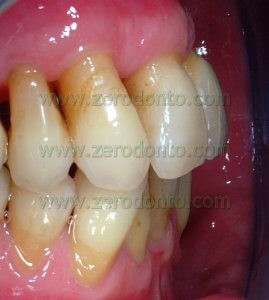
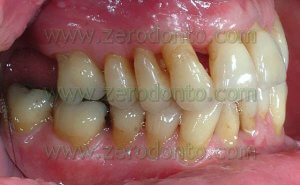
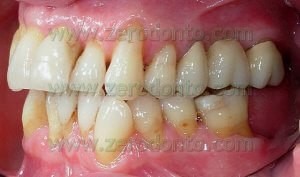
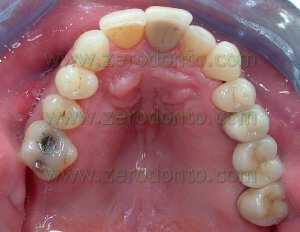
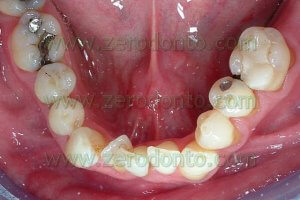
Pic. 7: Bonded retainer to achieve the alignment. The loops are activated in opening for about 2 mm and bonded in closing achieve the expansion of the arch.
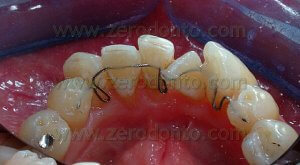
Pic. 8: Reduction of the crowding achieved after 6 weeks of treatment. A new retainer is applied to start the derotation of the dental elements.
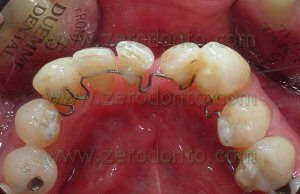
Pic. 9: To derotate the 32 an elastic chain was subsequently applied bonding it on the buccal surface of elements 32 and 33 with composite. A passive retainer was bonded lingually on elements 33, 34, 35 as stabilizing sectional. In the meantime the lingually bonded retainer kept on derotating the 43.
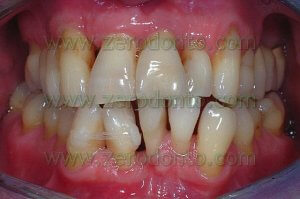
Pic. 10: When the derotation of the 32 was achieved, a passive retainer, put upon the previous active one, was bonded on elements 32 and 33 to stabilize them. Using a turret a step bend was shaped between elements 31 and 32 to align them in buccal-lingual direction. The segment of retainer bonded on the 43 was activated so as to derotate that very element.
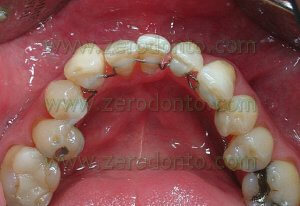
Pic. 11: The last stages of the alignment are carried out using a 0.12 Ni-Ti wire.
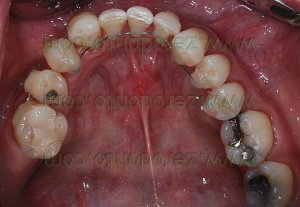
Pic. 12: Frontal view, from canine to canine, after the alignment achieved after about 10 months.
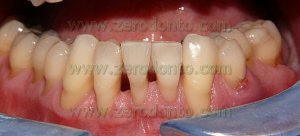
Pic. 13: Occlusal view.
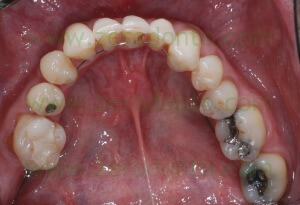
Conclusions
Lingual therapy without brackets using active retainers and Ni-Ti wires bonded on the lingual surface of the teeth makes it possible to carry out alignment therapies that are completely invisible and very well tolerated by the patients. This therapy is indeed little annoying for the tongue and the soft tissues and, as reported by the patients, by far less annoying than lingual brackets. Phonetic alterations have rarely occurred and only for the first few days. To solve more complex cases (e.g. class II and class III malocclusions, bilateral cross, deep or open bite, etc.) it is possible to carry out a lingual therapy without brackets using active retainers and Ni-Ti wires in conjunction with other devices, such as micro-screws, stabilizing sectionals bonded directly on non visible surfaces of the teeth, Quad Helix, etc.
Bibliografia
1. Macchi A, Cirulli N. “Fixed Active Retainer for Minor Anterior Tooth Movement”. Journal of Clinical Orthodontics, 2000.
2.Macchi A, Rania S, Cirulli . “Una proposta per la gestione di disallineamenti anteriori: il mantenitore attivo di contenzione (MAC)”. Mondo Ortodontico, 1999.
3.Liou EJW, Chen LIJ, Huang CS. “Nickel-titanium mandibular bonded lingual 3-3 retainer: for permanent retention and solving relapse of mandibular anterior crowding”. Am J Orthod Dentofacial Orthop 119:443-9, 2001.
4.Musilli M. The Bracketless Fixed Orthodontics: nine years of clinical Experimentation. Prog in Orthod 9:72-91, 2008.
5.Mariniello A, Cozzolino F. Lingual active retainers to achieve teeth levelling in orthodontics: case series. International Dentistry SA Vol 10 N 5, pag. 24-29, 2008. (FULL TEXT)
6.Burstone CJ, Koening HA. Creative wire bending-the force system from step and V bends. Am J Orthod Dentofac Orthop 93:59-67, 1988.
7.Burstone CJ, Koening HA. Force system from an ideal arch. Am j Orthod 65:270-289, 1974.
8.Ronay F, Kleinert W, Melsen B, Burstone CJ. Force system developed by V bends in an elastic orthodontic wire. Am J Orthod Dentofacial Orthop 96(4):295-301,1989.
For information:
zerodonto@gmail.com
tel. 0039 081 2451805

